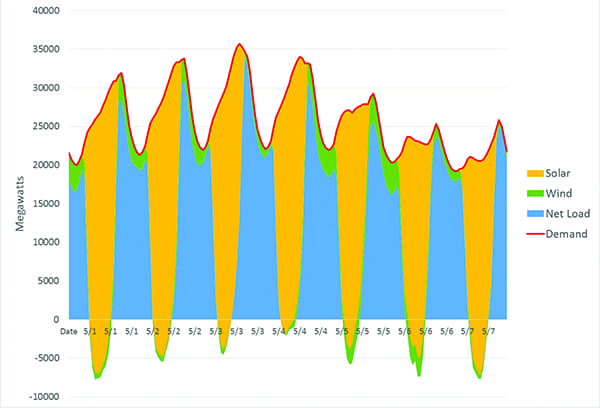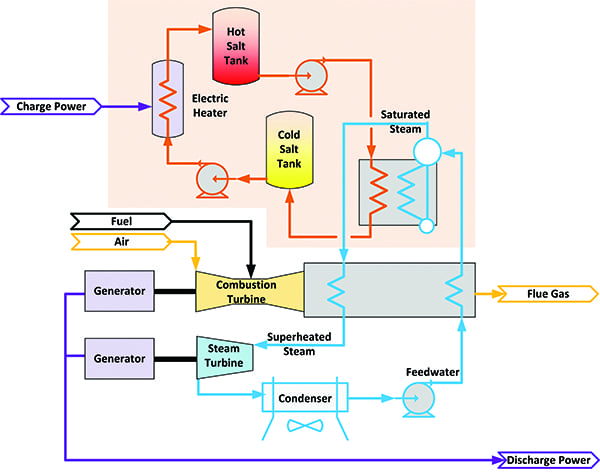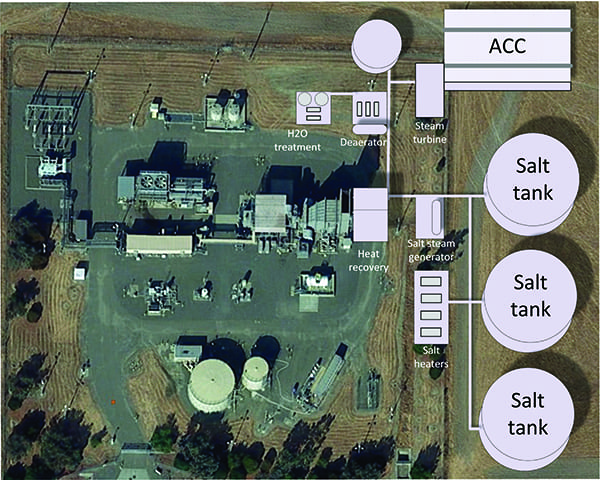Decarbonizing with Energy Storage Combined Cycles
Low asset utilization is an increasing financial challenge for both conventional and renewable assets, which are sometimes curtailed due to over-generation at various times of day. Integrating large-scale thermal energy storage with combustion turbines in a Liquid Salt Combined Cycle can transform thermal generation assets into low-carbon resources that deliver capacity and energy at far lower cost than batteries.
Solar and wind resources are displacing conventional generation, which is increasingly used to follow and firm variable generation. Thermal plants are operating at reduced capacity factors, are called on for load-following, and are being cycled, sometimes requiring two starts per day. Under these conditions, the heat rate increases, emissions limit run-time, and thermally stressed components have dramatically shortened useful lifetimes.
Renewable over-generation and fast ramps up and down, such as depicted in the California Independent System Operator’s (CAISO’s) Duck Curve, create reliability challenges for grid operators. Market prices are increasingly volatile, often introducing negative prices in day-ahead markets, driving baseload retirements. Extended cloudy periods have challenged reliability in Hawaii, while becalmed wind generators have driven price spikes on the Electric Reliability Council of Texas (ERCOT) system.
But as renewable deployment increases, it is not only thermal generators that must adapt. Having achieved its 30% renewable portfolio standard (RPS) goal, CAISO was forced, for example, to curtail almost 32 GWh of renewable power generation on April 21, 2019. By the middle of the next decade, over-generation is expected to be a daily occurrence as shown in Figure 1.
 |
|
1. Up to 100 GWh of daily storage would be needed to avoid renewable curtailment when California’s renewable portfolio standard exceeds 50%. Source: California Energy Storage Alliance and LS Power analysis of CAISO Open Access Same-time Information System (OASIS) Data (2016), 2030 IRP [Integrated Resource Plan] Proposed Reference System Plan Scenario |
The power industry requires energy storage to play a critical role in the low-carbon transition, with North American potential estimated to exceed 100 GW, according to a presentation given by Ilya Chernyakhovskiy, who is a member of the Grid Systems Group in the Strategic Energy Analysis Center at the National Renewable Energy Laboratory (NREL). Chernyakhovskiy spoke in September at the Advanced Clean Energy Summit in Denver. He suggested for capacity and renewable time-shifting with duration of four to 12 hours, the storage system costs will need to be less than $150/kWh to make economic sense.
All Energy Storage Is Not Created Equal
Storage systems are comprised of charging and discharging systems that transform electricity to and from the internal energy of a storage medium. Different approaches are taken to achieve cost reductions.
Some technologies share charging and discharging equipment to reduce cost. These include reversible pump-turbines for pumped storage hydro (PSH) and rectifier-inverter power electronics for electro-chemical batteries. Others, such as compressed air energy storage (CAES), use independent charging and discharging equipment.
Some technologies use cellular storage, while others use bulk storage media (such as water, air, gas, or flowing liquid electrolytes). Bulk storage tends to reduce the system cost at large scale, because adding more storage only requires a larger tank or reservoir, which enables economy of scale. Cellular batteries replicate modules to add more energy, so cost reduction relies on manufacturing economy, with modest scale effects.
Storage technologies also differ in their siting characteristics. Some require geological, topological, and hydrological features, while others can be more readily sited, subject to storage density and safety considerations.
Hybrid Systems Use Two Efficiency Metrics
Some storage technologies, like CAES and Liquid Salt Combined Cycle (LSCC), are hybrids that use two energy inputs—electricity during charging and fuel or waste heat during discharging. Hybrids can discharge more electric energy than was stored, so the term “roundtrip efficiency” is confusing.
Instead, the American Society of Mechanical Engineers (ASME) performance test code (PTC-53) Mechanical and Thermal Energy Storage Systems specifies the following performance metrics:
- ■ Fuel Heat Rate. Expressed as Btu/kWh, fuel heat rate is the ratio of fuel energy consumed per electricity produced. This is the customary efficiency for thermal power plants.
- ■ Electrical Rate. Expressed as kWh/kWh, electrical rate is the ratio of electrical energy consumed per unit of electricity produced (the inverse of roundtrip efficiency used for single input storage systems).
These performance metrics are convenient for calculating the marginal cost of energy (MCOE) discharged from storage, using the following equation:
MCOE = (fuel heat rate x fuel cost) + (electrical rate x power cost)
Hybrid Thermal Energy Storage Plus Thermal Generation
Pintail Power’s patented LSCC technology synergistically integrates molten salt thermal energy storage with combustion turbine exhaust heat, as shown in Figure 2. The new elements of the hybrid are shown within the orange area, including a two-tank molten salt storage system, an electrical resistance heater for charging, and a molten salt steam generator that uses stored energy to boil water.
 |
|
2. Pintail Power’s patented Liquid Salt Combined Cycle includes a two-tank molten salt energy storage system and a boiler that produces saturated steam from stored energy. The salt is electrically heated to store energy in the hot salt tank. After energy is extracted, salt is stored in the cold salt tank. Courtesy: Pintail Power |
A key innovation is moving the boiler outside the gas path, reserving exhaust gas for heating feedwater to the boiler and superheating steam from the boiler. This increases the available steam flowrate by 2.5 to 3 times compared to conventional heat recovery steam generation, resulting in substantially higher steam cycle power output.
The fuel heat rate is typically about 4,600 Btu/kWh, compared to about 6,600 Btu/kWh for a conventional combined cycle using the same turbine. Moreover, fast startup is enabled by removing heavy-wall components from the exhaust gas path, employing a single-pressure 565-psia (38-bar), non-reheat steam cycle, and using low-cost excess renewable energy to keep the steam cycle ready to run.
LSCC Works with Any Turbine
LSCC can be applied wherever there is wind or solar over-generation, reducing curtailment of renewable energy by storing and using it to displace fuel and decarbonize. LSCC can provide:
- ■ Flexible capacity and renewable integration to improve grid stability and reduce curtailment.
- ■ Resiliency by assuring dispatchable low-carbon power to meet local capacity needs and providing islanding and microgrid capability for extreme events.
- ■ Storage, heat, and power to meet facility thermal and electric demands, while maximizing renewable energy and minimizing greenhouse gases.
- ■ Fuel savings for islands, mines, or remote communities.
Whatever the turbine, hybrid integration results in substantial fuel savings, more bottoming-cycle capacity, and efficient recovery of stored energy. As illustrated in Table 1, the fuel heat rate is generally about half that of a simple cycle gas turbine, and the electrical rate is less than one.
 |
|
Table 1. Indicative performance estimates at ISO, 60 Hz, with air-cooled condenser and net of plant load. Estimates use Ebsilon Professional power plant design software. Source: Pintail Power |
Molten Salt Storage Is Safe and Proven
Molten salt thermal energy storage is in use at concentrated solar power (CSP) plants in Spain, the Middle East, and at the 250-MW Solana Generating Station in Gila Bend, Arizona, which includes twelve 120-foot-diameter tanks storing 4,000 MWh of thermal energy.
Rather than using solar salt, which freezes at 460F (238C), LSCC uses a lower freezing point 288F (142C) eutectic salt, such as the HITEC heat transfer and storage medium from Coastal Chemical. This mixture of water-soluble, inorganic salts of potassium nitrate, sodium nitrite, and sodium nitrate is safe, non-flammable, non-explosive, and non-toxic. It provides exceptional heat transfer performance in a low-cost, reliable, and compact system.
The salt is heated to 800F (427C) as it circulates through parallel trains of medium-voltage electric heaters, such as the 10-MW, 6.6-kV units available from Chromalox. Electric heaters are inexpensive and flexible, offer high turn-down for demand response, single-cycle response for frequency control, and provide accurate temperature regulation. High-temperature salt is kept in an insulated carbon-steel hot tank, where thermal losses are typically less than 1C per day.
During discharge, the salt is circulated through a molten salt steam generator, available from a range of suppliers with experience on CSP projects. Aalborg CSP provides ASME-compliant boilers with the molten salt on the shell side of elevated heat exchangers to facilitate gravity drainage of salt when not in use, and it offers a guaranteed leak-free design. The boiler can be kept hot to provide instant startup or can ramp from a cold condition to full power in less than 30 minutes. The salt exits the steam generator at about 483F (250C), far above its freezing point.
At these conditions, carbon steel is suitable for tanks and piping, so the hot and cold storage tanks can be identical in construction. Three or more tanks can be used in a round-robin arrangement to provide redundancy and increase the storage density. A typical LSCC application requires about 12.25 metric tons of salt per MWh of delivered energy at a cost of roughly $2,000 per metric ton, or about $25/kWh, a fraction of the incremental cost of lithium batteries.
LSCC Provides Compact Low-Carbon Capacity
High-density and low-cost media make large-scale storage practical as illustrated in Figure 3, which shows three 92-foot diameter tanks, each capable of holding more than a GWhe of energy. In this example with an LM-6000 combustion turbine, the overall plant is rated at 91 MWe net, so the three tanks (two full and one empty) can provide 24 hours of full-load discharge.
 |
|
3. Conceptual arrangement of a storage add-on to a peaking plant, using a conventional steam system. To minimize the cost of storage, three identical tanks are used in a round-robin scheme, alternately 2-hot/1-empty when fully charged and 2-cold/1-empty when fully discharged. Courtesy: Pintail Power |
Large-capacity storage tanks enable operators to optimize both economy and reliability. The system could be charged over the weekend, absorbing otherwise curtailed energy when available at the lowest cost. Throughout the week, the system could provide resource adequacy—discharging four hours a day during peak times from Monday to Friday.
An LSCC maintains resource adequacy without needing to immediately recharge with expensive or carbon-intensive electricity. During a contingency, the LSCC could operate longer, recharge itself, and if storage was spent, continue operating as a simple cycle. This provides superior reliability during extended weather, emergency, or transmission events.
When over-generation becomes the daily event predicted in Figure 1, the LSCC system can aid decarbonization by providing low-carbon power overnight to increase the capacity factor of both renewable and gas generating assets.
Hybrids Lower the Cost of Storage
The cost of storage at 100-MW scale, shown in Table 2, is taken from the Lazard levelized cost of storage reports (battery technologies from 2019, PSH and CAES from 2016) and Pintail Power’s estimates for LSCC. Only the LSCC, and potentially the CAES hybrid, are projected to meet the $150/kWh cost requirement suggested by NREL’s Chernyakhovskiy.
 |
|
Table 2. Estimated specific installed cost of 100-MW energy storage systems. Source: Lazard and Pintail Power |
Lithium-ion technology has been the battery cost leader, but the pace of future cost reduction may be challenged by supply chain constraints, electric vehicle demand, and safety concerns. The National Fire Protection Association Standard for the Installation of Stationary Energy Storage Systems (NFPA 855) imposes new requirements that may also limit the rate of future cost reductions. Safety and prudence concerns raised by Arizona Corporation Commissioner Sandra Kennedy about hydrogen fluoride emissions may also inhibit lithium-ion battery deployment. Flow batteries are expected to benefit from industrialization, and, unlike the lithium-ion cellular technology, also benefit from economy of scale, but substantial cost reductions will be needed.
By combining low-cost electric charging, low-cost bulk storage media, and proven combined cycle equipment, LSCC can meet the $150/kWh target as a new-build system with a 12-hour duration, while adding LSCC to an existing plant can reduce the cost below $100/kWh. Further cost reductions can be achieved with larger-scale plants, two-pressure steam cycles, or by adopting solid thermal storage media that proponents claim would be lower cost than molten salt.
Benefits Abound
LSCC technology integrates proven thermal storage systems and thermal generation systems already deployed in utility service around the world to provide novel synergies that improve efficiency, while reducing size, capital, and operating costs. LSCC technology offers the following advantages:
- ■ Very high energy density stores more energy on the available land to assure reliable discharge and optimize the cost of stored energy.
- ■ Safe thermal energy storage eliminates the fire, explosion, toxicity, disposal, and environmental issues of lithium batteries.
- ■ Low capital cost by combining proven low-cost molten salt bulk storage with proven power generation equipment to achieve economies of scale.
- ■ Even lower costs are achieved by upgrading existing power plants with storage resources.
- ■ Decarbonization by storing otherwise curtailed renewable energy to achieve unprecedented high fuel efficiency during discharge and make use of renewable fuel economic.
- ■ Long lifetime without degradation of storage media.
- ■ Flexible charging and discharging without the rate of charge or state of charge constraints of batteries.
- ■ Low fuel heat rate sets the stage for economical use renewable fuels, as they become commercially available to fully decarbonize.
Energy storage is becoming more important than ever, as renewable energy resources on the power grid grow. While all types of storage are important and useful in certain applications, LSCC utilizes readily available, proven technology to transform thermal generation assets into low-carbon resources that deliver capacity and energy at far lower cost than other storage systems. By improving renewable utilization, LSCC enables increased penetration as well as investment in green and renewable fuels. ■
—Bill Conlon, PE, PhD is founder and president of Pintail Power LLC.